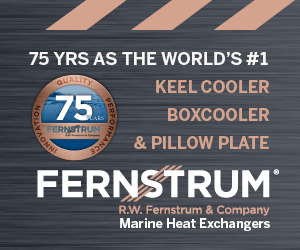IMX: Tier 4 Engines And Supply Chain Updates
Inland Marine Expo, held virtually this year, one of the most technically informative sessions was “Tier 4 Engines and Supply Chain Updates.” Panelists from companies that produce marine diesel engines shared their companies’ varied strategies and innovations for delivering solutions that help marine operators meet Tier 4 emissions standards while minimizing costs as much as possible.
The panel was hosted by Jim Mundth, segment leader-dredge and inland waterways for Caterpillar’s Marine division. Tim Peters, marine application engineer at MTU Engineering Company Ltd., discussed the various technologies that engine makers have used to meet Tier 4 requirements, including fuel injection, the Miller cycle and turbocharging.
SCR Systems
Most of the marine market, said Peters, has moved to selective catalytic reduction (SCR) technology. That solution does impose some added costs, not all of which can be completely avoided. An engine using SCR requires a supply of urea that’s injected into a closed-loop system. Peters acknowledged that installing such systems does increase the footprint and cost of vessel construction. In addition, the Environmental Protection Agency is requiring that all components of such systems be verified and recorded.
Such systems have several benefits, though. They can be added to engine models that are similar to existing models and are thus familiar to engine-makers, vessel architects and boat operators alike. SCR systems reduce exhaust-borne noise and have no impact on transient performance, the power surges that towing vessels need during maneuvering and barge-handling. If SCR systems fail, the engine remains operable. The population of Tier 4 boats is growing, along with the operational expertise in working with those systems.
Rich Kulaga, manager of business development at Caterpillar, said that his company, in developing its Tier 4 solutions, sought to emphasize the voices of its customers, the shipyards and designers. Their goal was to minimize construction costs and “keep it simple,” enabling ease of operation while providing maximum flexibility. Their Tier 4 engines use 60 percent less lube oil and 20 percent less diesel fuel than existing designs, while emitting very low NOx and smoke during transient operations. In the E 23B engine family, the SCR unit is patented and integrated with the engine for easy installation. When it was installed on Canal Barge’s mv. H. Merritt “Heavy” Lane Jr., it was the first electro-motive diesel (EMD) Tier 4 engine operating on the Lower Mississippi. It’s being installed on two Bouchard boats and two ferries.
Jon Burton, senior marine product specialist at Cat Marine, said the company was working on a separable SCR system easier to install in smaller engineroom spaces. He said there is widening acceptance of SCR in the industry, beginning with towboats.
Storage And Supply Chain
Tony Odak, vice president and chief operating officer at John W. Stone Oil Distributor LLC, spoke of how his company decided early on to build out the infrastructure to support urea systems. The particular type of urea used in Tier 4 engines, diesel exhaust fluid (DEF), is a “purified fertilizer” mixed with deionized water to a strength of either 32.5 percent or 40 percent urea (the two grades can’t be mixed). Stainless steel tanks are a must to avoid contamination, since even mere teaspoons of impurities could contaminate an entire tanker-load. Odak said, “Use the same precautions [with DEF] that you would with diesel fuel, but don’t be afraid of it.”
David Reynolds, vice president and managing director of Economy Boat Store, addressed concerns about the supply chain for DEF. He said there is already a long history of companies managing the supply chain for offshore vessels. Economy and other suppliers have distributed “millions of gallons” of DEF overall, and thousands on the inland waterways. There are tanks, pumps, hoses and nozzles specific to DEF. “It is a high-maintenance product to some extent,” he acknowledged, with either stainless steel or poly tanks required.
In the Q&A period, Peters reiterated that if a DEF system fails, it doesn’t stop the engine. A failure might make the vessel liable to emissions violations, though, and alarms must be reported to the EPA, along with fixes to any failures.



